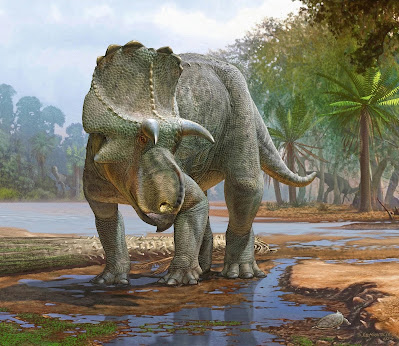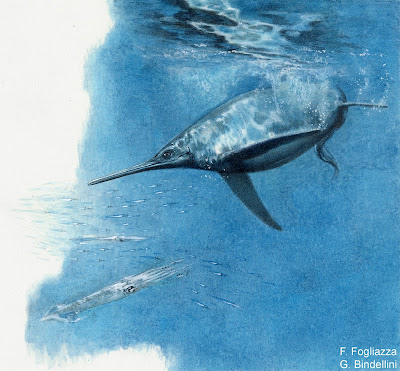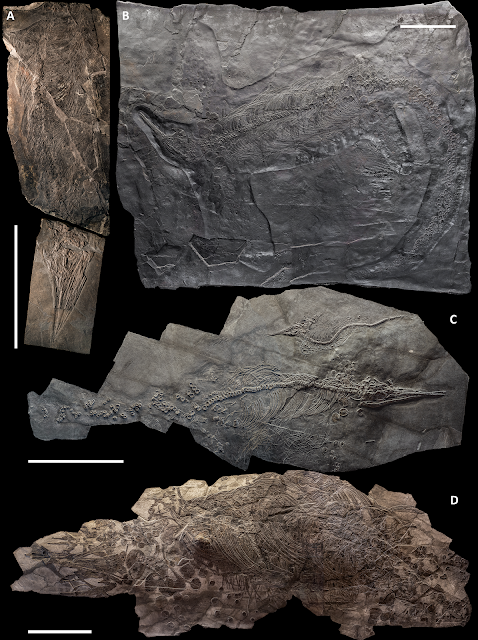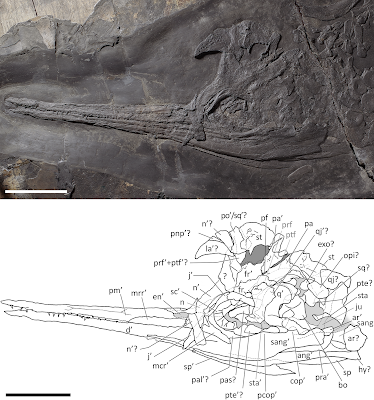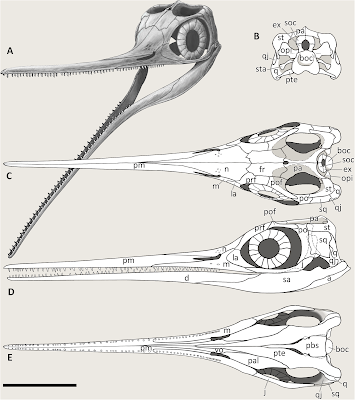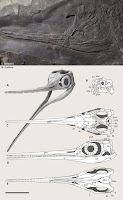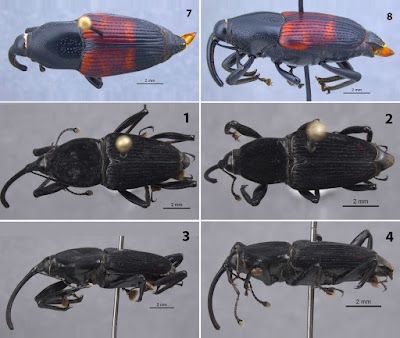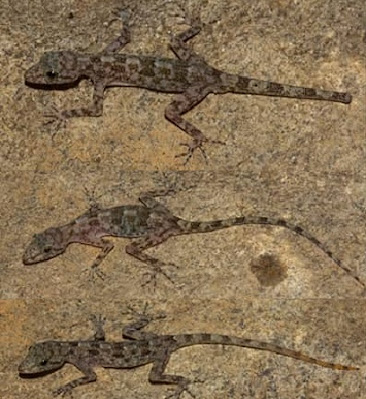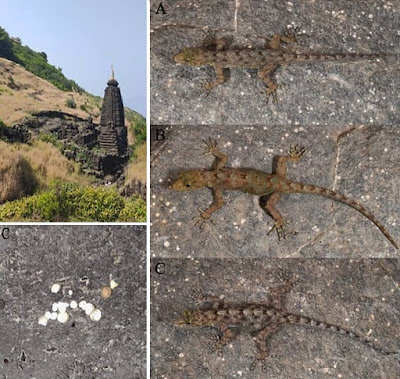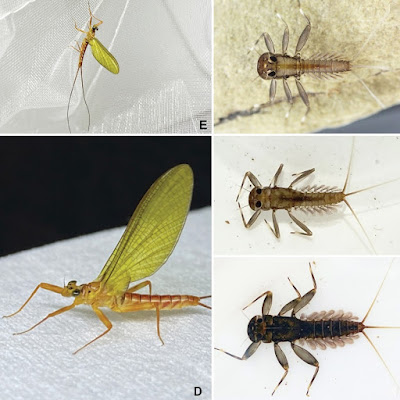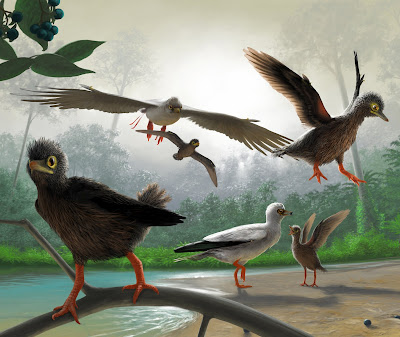[Most Recent Entries] [Calendar View]
Tuesday, May 11th, 2021
| Time | Event | ||||
| 4:31a | [Paleontology • 2021] Menefeeceratops sealeyi • The Oldest Centrosaurine: A New Ceratopsid Dinosaur (Dinosauria: Ceratopsidae) from the Allison Member of the Menefee Formation (Upper Cretaceous, early Campanian), northwestern New Mexico, USA
Abstract An associated incomplete skeleton of a ceratopsid dinosaur from the Campanian deposits of the Allison Member of the Menefee Formation in New Mexico, USA is described. Although it was originally described over two decades ago, newly prepared portions of the Menefee Formation skeleton and reinterpretations of previously known morphology, in addition to newly described specimens have provided new information on ceratopsids, and centrosaurines in particular. These new data allow for a thorough reassessment of the specimen and the erection of a new taxon: Menefeeceratops sealeyi gen. et sp. nov., potentially the oldest recognized member of Centrosaurinae. Menefeeceratops sealeyi is represented by diagnostic cranial and postcranial skeletal elements. The cranial elements include a portion of the left premaxilla, a nearly complete left postorbital horncore, a parietal fragment, the right and left squamosals, the left jugal, the predentary, and the left dentary. Postcranial material consists of two cervical vertebrae, eight dorsal vertebrae, a partial sacrum with six sacral vertebrae, 11 dorsal ribs, the distal left radius, proximal and distal portions of the left ulna, the left femur, and a left metatarsal II. The taxonomic validity of Menefeeceratops sealeyi is supported by a combination of several morphological characters. These include a lack of epiossifications on the lateroposterior edge of the parietal (shared with Machairoceratops), three epiossifications on the squamosal, and three smaller, secondary undulations as part of episquamosal locus S1. There are also two subequal embayments on the posterior free margin of the squamosal with the more dorsal embayment (between episquamosal loci 1 and 2) distinctly larger than the ventral (= lateroventral) one (between episquamosal loci 2 and 3), three ridges on the lateral (dorsolateral) surface of the squamosal, an elongate posterior portion of the squamosal, the presence of a shallow but distinct groove on the medial surface of the squamosal nearly paralleling the ventrolateral and ventroposterior edges, elongate postorbital (= supraorbital) horns that are anteriorly curved distally, and two elongate ridges on the lateral surface of the dentary that diverge anteriorly, creating a distinct anterior triangular fossa. Phylogenetic analysis of Menefeeceratops sealeyi places this new species as a basal centrosaurine, most closely related to Crittendenceratops krzyzanowskii, thus adding to the growing record of centrosaurines discovered in western North America. It thus provides new information about the diversity of morphologies throughout different species and the temporal and paleobiogeographic distribution of these animals throughout Laramidia during the Late Cretaceous. Its presence as one of the, if not the, oldest members of the Centrosaurinae also suggests centrosaurines originated in the southern portions of western North America and the southern Rocky Mountain region, and subsequently radiated north during the upper middle to late Campanian. Keywords: Dinosauria, Ceratopsidae, Centrosaurinae, Late Cretaceous, New Mexico, North America, Taxonomy, Evolution Systematic paleontology Ornithischia Seeley, 1887 Ceratopsia Marsh, 1890 Neoceratopsia Sereno, 1986 Ceratopsidae Marsh, 1888 Centrosaurinae Lambe, 1915 Menefeeceratops gen. nov. Type species. Menefeeceratops sealeyi gen. et sp. nov. Menefeeceratops sealeyi gen. et sp. nov. Material. Holotype. NMMNH P-25052, a fragmentary skeleton consisting of the following elements: a left partial premaxilla, the nearly complete left postorbital horncore, a partial right squamosal, the left squamosal, an incomplete left parietal, the left jugal, the predentary, the left dentary, one cervical vertebra, eight dorsal vertebrae, a partial sacrum consisting of six sacral vertebrae, 11 dorsal ribs, the left ilium, the distal left radius, the proximal and distal portions of left ulna, the left metatarsal II, the left femur, and the distal end left fibula. The holotype of Menefeeceratops sealeyi was collected under a permit issued by the U.S. Bureau of Land Management to the New Mexico Museum of Natural History and Science, Albuquerque, New Mexico. Etymology. The generic epithet includes “Menefee” in reference to the Menefee Formation in which the type specimen was found. The Greek suffix “ceratops” (= horn-face) denotes membership in Ceratopsidae, which includes the new species. The specific epithet honors Paul Sealey, who discovered the type specimen.
Conclusions: Menefeeceratops sealeyi is a new genus and species that represents the oldest current record of centrosaurine ceratopsid in North America (Fig. 24). It is basal to Centrosaurini and Pachyrhinosaurini and potentially is a member of the “Nasutoceratopsini”. Recognition of Menefeeceratops sealeyi adds to the growing species diversity of the Centrosaurinae in North America, and its presence in southern Laramidia fills in part of the evolutionary gap between the earlier Zuniceratops christopheri (~ 90 Ma) and the more derived ceratopsids known from the late Campanian in North America. The phylogenetic analysis suggests that derived members of the Centrosaurinae evolved rather quickly and lived at the same time as basal members. The presence of the oldest members of the Centrosaurinae in southern Laramidia suggests the clade evolved in the south and radiated north through the late Campanian. This is further corroborated by the presence of Campanian strata (~ 80 Ma) to the north (Alberta and Montana) that currently lacks evidence of centrosaurines. More material is needed, particularly of the parietal, to determine a more confident phylogenetic position of M. sealeyi and other potential “nasutoceratopsins” at, or near, the base of the Centrosaurinae. Sebastian G. Dalman, Spencer G. Lucas, Steven E. Jasinski, Asher J. Lichtig and Peter Dodson. 2021. The Oldest Centrosaurine: A New Ceratopsid Dinosaur (Dinosauria: Ceratopsidae) from the Allison Member of the Menefee Formation (Upper Cretaceous, early Campanian), northwestern New Mexico, USA. PalZ. DOI: 10.1007/s12542-021-00555-w | ||||
| 6:57a | [Paleontology • 2021] Cranial Anatomy of Besanosaurus leptorhynchus Dal Sasso & Pinna, 1996 (Reptilia: Ichthyosauria) from the Middle Triassic Besano Formation of Monte San Giorgio, Italy/Switzerland: Taxonomic and Palaeobiological Implications
Abstract Besanosaurus leptorhynchus Dal Sasso & Pinna, 1996 was described on the basis of a single fossil excavated near Besano (Italy) nearly three decades ago. Here, we re-examine its cranial osteology and assign five additional specimens to B. leptorhynchus, four of which were so far undescribed. All of the referred specimens were collected from the Middle Triassic outcrops of the Monte San Giorgio area (Italy/Switzerland) and are housed in various museum collections in Europe. The revised diagnosis of the taxon includes the following combination of cranial characters: extreme longirostry; an elongate frontal not participating in the supratemporal fenestra; a prominent ‘triangular process’ of the quadrate; a caudoventral exposure of the postorbital on the skull roof; a prominent coronoid (preglenoid) process of the surangular; tiny conical teeth with coarsely-striated crown surfaces and deeply-grooved roots; mesial maxillary teeth set in sockets; distal maxillary teeth set in a short groove. All these characters are shared with the holotype of Mikadocephalus gracilirostris Maisch & Matzke, 1997, which we consider as a junior synonym of B. leptorhynchus. An updated phylogenetic analysis, which includes revised scores for B. leptorhynchus and several other shastasaurids, recovers B. leptorhynchus as a basal merriamosaurian, but it is unclear if Shastasauridae form a clade, or represent a paraphyletic group. The inferred body length of the examined specimens ranges from 1 m to about 8 m. The extreme longirostry suggests that B. leptorhynchus primarily fed on small and elusive prey, feeding lower in the food web than an apex predator: a novel ecological specialisation never reported before the Anisian in a large diapsid. This specialization might have triggered an increase of body size and helped to maintain low competition among the diverse ichthyosaur fauna of the Besano Formation.
Besanosaurus leptorhynchus Dal Sasso & Pinna, 1996 Conclusions: In general, the specimens here described preserve and represent a remarkably complete cranial anatomy, so that Besanosaurus leptorhynchus now is among the best-understood Middle Triassic Ichthyosaur taxa to date. Our revision of the skull morphology of this taxon clarified long-standing controversies regarding its cranial anatomy and the taxonomy of shastasaurids from Monte San Giorgio. Based on this rich fossil material, we have demonstrated that Mikadocephalus gracilirostris (GPIT 1793/1) is a junior synonym of Besanosaurus leptorhynchus, providing evidence to refute previous hypotheses (Maisch & Matzke, 1997a, 2000; Maisch, 2010) about the co-occurrence of two different shastasaurid taxa (Besanosaurus and Mikadocephalus) in the Besano Formation. The six specimens here described represent a potential ontogenetic series covering a certain size range of mainly adult and potentially subadult specimens (Fig. 19), ordered by increasing size as follows: PIMUZ T 4376, PIMUZ T 1895, BES SC 999, BES SC 1016, GPIT 1793/1, PIMUZ T 4847. An allometric growth signal, yet to be fully tested, has also been detected. Other sources of intraspecific variation such as sexual dimorphism, cannot be ruled out, however, partly due to the limited dataset. Here we also report evidence that Besanosaurus was the largest Middle Triassic ichthyosaur taxon of the Western Tethys since we confidently estimate a fully adult size of about 8 m for specimen PIMUZ T 4847. Besanosaurus possesses an extremely long, slender, and gracile snout, representing an ecological specialization never seen before the Anisian in a large sized (~8 m) diapsid. The diagnostic, prominent coronoid (preglenoid) process of the surangular and a large rugose area for the attachment of the mAMES allow to infer the presence of well-developed jaw closing muscles, which likely had an important functional role: we assume an efficient and fast jaw closing movement and hypothesize a snap-feeder-like hunting strategy, with a specific preference for small and elusive prey (such as coleoids and/or small fishes). Among the ichthyosaurian Besano-Monte San Giorgio Fauna (Cymbopondylus, mixosaurids, and Besanosaurus), different hunting strategies, demonstrated by different morphologies and dimensions of the rostra, should have led to the maintenance of low interspecific competition (i.e., niche partitioning). We also hypothesize that the specialization represented by a longirostrine morphology might have been driven by prey preference and the methods of prey capture. Mixosaurus and Cymbospondylus show almost a global distribution; on the contrary, Besanosaurus is known only from the Besano Formation (Italy and Switzerland). A wider distribution of this genus is expected (and supported by McGowan & Motani, 2003: 135–136): it seems unlikely to us that Besanosaurus would be represented only in the Alpine Tethys realm. Last but not least, the importance of Besanosaurus is not only given by the completeness and remarkable preservation of its remains, and its ecological role, but also by the key phylogenetic position occupied by the taxon in the ichthyosaurian phylogeny: our analysis, performed with a matrix that includes around 90% of unambiguous scores for B. leptorhynchus and revised scores for other Triassic taxa, shows that this taxon represents the basalmost member of shastasaur-grade ichthyosaurs. Gabriele Bindellini, Andrzej S. Wolniewicz, Feiko Miedema, Torsten M. Scheyer and Cristiano Dal Sasso. 2021. Cranial Anatomy of Besanosaurus leptorhynchus Dal Sasso & Pinna, 1996 (Reptilia: Ichthyosauria) from the Middle Triassic Besano Formation of Monte San Giorgio, Italy/Switzerland: Taxonomic and Palaeobiological Implications. PeerJ. 9:e11179. DOI: 10.7717/peerj.11179 | ||||
| 8:25a | [Entomology • 2021] Metamasius onorei & M. pilirostris • Two New Species of Metamasius Horn, 1873 (Coleoptera: Curculionidae: Dryophthorinae) from Ecuador and Colombia
Abstract Two new species of South American Metamasius Horn (Coleoptera: Curculionidae: Dryophthorinae) are described: Metamasius onorei new species from Cotopaxi, Ecuador and Metamasius pilirostris new species from west of Río Yurumangui, Colombia. Diagnostic characters and images are provided for both new species to facilitate identification. Keywords: Coleoptera, biodiversity, species discovery, weevils Robert S. Anderson. 2021. Two New Species of Metamasius Horn, 1873 (Coleoptera: Curculionidae: Dryophthorinae) from Ecuador and Colombia. Zootaxa. 4966(5); 596–600. DOI: 10.11646/zootaxa.4966.5.10 | ||||
| 9:22a | [Herpetology • 2021] Cnemaspis krishnagiriensis • A New Medium-sized Rupicolous Cnemaspis Strauch, 1887 (Squamata: Gekkonidae) of the C. bangara Clade from Granite Boulder Habitats in Krishnagiri, Tamil Nadu, India
Abstract We describe a new species of the Cnemaspis bangara clade from a rocky hillock near Kugai Periya Mariamman Temple, Krishnagiri fort, Krishnagiri District of Tamil Nadu, India. Cnemaspis krishnagiriensis sp. nov. can be diagnosed from all other peninsular Indian congeners by its medium body size (maximum SVL 40 mm), heterogeneous dorsal pholidosis, spine-like tubercles absent on flanks; presence of four femoral pores on each thigh separated on either side by nine or 10 poreless scales from three continuous precloacal pores in males; tail with enlarged, strongly keeled, conical tubercles forming four whorls on anterior portion, six tubercles in first whorl, four tubercles in second to fourth whorls, enlarged tubercles restricted to only paravertebral region on rest of the tail; median row of sub-caudals smooth and distinctly enlarged, and a unique colour pattern. The new species can be diagnosed from members of C. bangara clade by the number of dorsal tubercles rows at mid-body, the number of enlarged tubercles in paravertebral rows, the number of ventral scales across belly at mid-body, the number longitudinal ventral scales from mental to cloaca, the number of femoral and precloacal pores and poreless scales separating these series, and subtle colour pattern differences; besides 9.2–17.6 % uncorrected ND2 sequence divergence. Cnemaspis krishnagiriensis sp. nov. is the fourth member of the recently described bangara clade and is the first that is known to be distributed <900 m asl.. The discovery of yet another endemic species of Cnemaspis from lower elevations of the Mysore Plateau once again highlights the need of dedicated systematic sampling to uncover the true diversity of Cnemaspis. We also address a nomenclatural issue related to the recently described Cnemaspis stellapulvis Khandekar, Thackeray & Agarwal. Keywords: Reptilia, Cnemaspis stellapulvis, dwarf geckos, endemic, microrefugia, ND2, nomenclature, South Asian Cnemaspis Ishan Agarwal, Tejas Thackeray and Akshay Khandekar. 2021. A New Medium-sized Rupicolous Cnemaspis Strauch, 1887 (Squamata: Gekkonidae) of the C. bangara Clade from Granite Boulder Habitats in Krishnagiri, Tamil Nadu, India. Zootaxa. 4969(2); 351–366. DOI: 10.11646/zootaxa.4969.2.7 | ||||
| 9:31a | [Herpetology • 2021] Cnemaspis uttaraghati • A Novel Small-bodied Rupicolous Cnemaspis Strauch, 1887 (Squamata: Gekkonidae) from the northern Western Ghats, Maharashtra, India, with Comments on the Status of C. indraneildasii, Bauer 2000
Abstract We describe a distinct new rupicolous Cnemaspis based on four adult specimens collected from the Kedareshwar caves on Harishchandragad mountain, from the northern Western Ghats, approximately 1200 m asl. in Ahmednagar district of Maharashtra state, India. Cnemaspis uttaraghati sp. nov. can be diagnosed from all other peninsular Indian congeners by its small body size (maximum SVL < 39 mm), heterogeneous dorsal pholidosis, presence of spine-like tubercles on flanks; presence of only femoral pores in males; tail with enlarged, strongly keeled, conical tubercles forming whorls; median row of sub-caudal scales smooth, slightly enlarged, regularly arranged with condition of two slightly larger scales alternating with a large divided scale. The new species is likely to be allied to the C. girii clade and can be diagnosed from its members by its slightly larger body size, presence of spine-like tubercles on flanks, the number of enlarged tubercles in paravertebral rows between forelimb and hindlimb insertions, the number of dorsal tubercle rows at mid-body, the number of ventral scales across belly at mid-body, the number of longitudinal ventral scales from mental to cloaca, and the number of lamellae under digit IV of manus. We also provide a detailed morphological dataset for C. goaensis and C. indraneildasii based on topotypic material and specimens collected from additional localities to confirm C. indraneildasii is a junior synonym of C. goaensis, and provide an updated diagnosis for C. goaensis. Keywords: Reptilia, Biodiversity Hotspot, dwarf geckos, endemic, Kalsubai-Harishchandragad Wildlife Sanctuary, morphology, South Asian Cnemaspis, taxonomy Akshay Khandekar, Tejas Thackeray and Ishan Agarwal. 2021. A Novel Small-bodied Rupicolous Cnemaspis Strauch, 1887 (Squamata: Gekkonidae) from the northern Western Ghats, Maharashtra, India, with Comments on the Status of C. indraneildasii, Bauer 2000. Zootaxa. 4969(2); 331–350. DOI: 10.11646/zootaxa.4969.2.6 | ||||
| 10:23a | [Entomology • 2021] Paegniodes sapanensis • First Record of Paegniodes Eaton, 1881 (Ephemeroptera, Heptageniidae) from Thailand with Description of A New Species
Abstract A new species of Heptageniidae, Paegniodes sapanensis sp. nov., is described based on larvae, subimagos, eggs, and COI data. The mayfly genus Paegniodes Eaton, 1881 is reported for the first time from Thailand. The larva of the new species can be distinguished from other known Paegniodes species by i) lamellae of gill I ca 1/4 of fibrilliform portion and ii) mandibles and basal segment of maxillary palp without dense setae on margin. The subimago characters useful to distinguish this new species from previously known species are i) the median stripes on abdominal terga and ii) shape of the female subgenital and subanal plates. The genetic distance between the new species and P. cupulatus (Eaton, 1871) was approximately 11%. The morphological characters of the new species are discussed and compared to other known species. Keywords: COI, diversity, mayfly, Southeast Asia
Order Ephemeroptera Family Heptageniidae Genus Paegniodes Eaton, 1881 Paegniodes sapanensis Boonsoong, Sartori & Auychinda, sp. nov. Diagnostic characters of imaginal stage: The diagnostic characters to distinguish our new species from P. cupulatus are: i) the median stripes on abdominal terga and ii) lateral margins of genital plates slightly concave near apex. Etymology: The specific epithet is named for the Sapan waterfall (Bo Kluea district; tourist attraction of Nan province, Thailand), where the holotype is known. Distribution: Nan province. Biological aspects: The specimens were collected from tropical mountain streams (Fig. 11A) which are slightly disturbed by tourist activities. The larvae of the new species were found in flowing areas and the littoral zone of the streams, underneath a mostly cobble substrate (Fig. 11B, C). Boonsatien Boonsoong, Chonlakran Auychinda, Michel Sartori and Nuttakun Khanyom. 2021. First Record of Paegniodes Eaton, 1881 (Ephemeroptera, Heptageniidae) from Thailand with Description of A New Species. ZooKeys. 1036: 153-170. DOI: 10.3897/zookeys.1036.64880 | ||||
| 11:40a | [PaleoOrnithology • 2021] A Juvenile Specimen of Archaeorhynchus Sheds New Light on the Ontogeny of Basal Euornithines
The ontogenetic development of extant birds is characterized by rapid growth, bone fusion and an early onset of flight ability. In contrast, little is known about how these ontogenetic traits evolved in the bird stem lineage, and the available data pertains primarily to Enantiornithes. Here, we describe an almost complete skeleton of a juvenile euornithine bird (LNTU-WLMP-18) from the Early Cretaceous Jiufotang Formation (Aptian), which was discovered near Lamadong Town (Jianchang County, Liaoning, China). Despite its completeness, bone preservation is rather poor. Thus, to increase the contrast between bone tissue and matrix, we used cyan-red-based autofluorescence photography. The specimen is more or less articulated and exposed in ventral aspect. The jaws are edentulous, the coracoid bears a procoracoid process, and the ischium lacks a proximodorsal process. The pedal unguals are short and barely curved, indicating a ground-dwelling lifestyle. Feathers, including long primaries, are present as carbonized traces. Several characters indicate that LNTU-WLMP-18 is a juvenile: the bone surface has a coarsely striated texture and no fusion is evident between the carpals and metacarpals, between the tibia and the astragalus and calcaneum, or among the metatarsals. Although juvenile characters have the potential to impede accurate identification of the specimen, morphological comparisons and cladistic analysis identify LNTU-WLMP-18 as most likely referable to the basal euornithine Archaeorhynchus, which would make the specimen the first juvenile bird from the Jehol Group that could be assigned to a specific taxon. Based on its size and the incomplete ossification of the bone surface, LNTU-WLMP-18 represents the smallest and therefore youngest known individual of this genus. A statistical comparison of limb proportions shows that the forelimbs of LNTU-WLMP-18 are significantly shorter than the hindlimbs, while the forelimbs are longer than the hindlimbs in subadult and adult individuals. This is different from the situation in some Enantiornithes, in which the forelimbs exceed the length of the hindlimbs even in hatchlings. Similar to Enantiornithes, Archaeorhynchus probably exhibit an early onset of flight ability, as indicated by the extensive wing plumage in LNTU-WLMP-18. Finally, the lack of gastroliths in the visceral cavity might indicate a dietary shift in Archaeorhynchus during ontogeny. As a small-bodied, ground-dwelling, seed-eating bird with a precocial ontogeny, Archaeorhynchus filled an ecological niche that later allowed early crown birds to survive the K-Pg mass extinction. Keywords: Euornithes, ontogeny, Early Cretaceous, China, bird evolution Christian Foth, Shiying Wang, Frederik Spindler, Youhai Lin and Rui Yang. 2021. A Juvenile Specimen of Archaeorhynchus Sheds New Light on the Ontogeny of Basal Euornithines. Front. Earth Sci. 9:604520. DOI: 10.3389/feart.2021.604520 |
| << Previous Day |
2021/05/11 [Calendar] |
Next Day >> |
